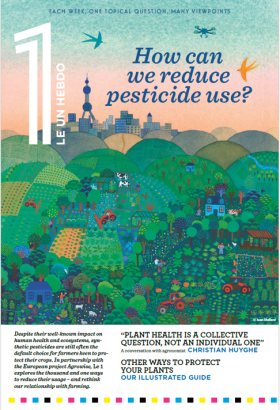Agroecology Reading time 5 min
How can we reduce pesticide use?
Despite their well-known impact on human health and ecosystems, synthetic pesticides are still often the default choice for farmers keen to protect their crops. In partnership with the European project Agrowise, Le 1 explores the thousand and one ways to reduce their usage – and rethink our relationship with farming.
Published on 15 October 2025


In the battle to protect crops, chemical solutions have been the main stay since the post-war period. Today, nearly 500 active substances are authorized in Europe for use in pesticides. Given the now well-documented harm to farmers’ and consumers’ health, the soil and water pollution, the collapse of biodiversity and the increased resistance of pests to chemicals, it has become crucial to adopt other methods of protecting crops.
Many alternatives already exist, and more are constantly being invented.
To explore this non-chemical arsenal, Le 1 has joined forces with the European Agrowise project, which brings together research organisations from across Europe to provide recommendations to all agricultural stakeholders on how to reduce pesticide use and impact.
In this special issue – created in collaboration with INRAE and Agrowise teams – we hear from people who work the land. They share their experiences, challenges and successes in reducing pesticide use. In a large poster, we explore the many alternatives to chemicals. We also consider the crucial role played by the agricultural sector as a whole, as well as that of banks, insurance companies, and consumers, in making this transition possible.
Plant health is a collective question, not an individual one
Christian Huyghe, INRAE
AGROWISE - Guidelines for farm-specific rules for mitigating pesticide impacts while ensuring sustainable agriculture.
AGROWISE is a an 18-month project (01/05/2024-31/10/2025) which is led by a consortium of 8 European research organizations: INRAE – Coordinator (France), Zalf (Croatia), JKI (Germany), Teagasc (Ireland), University of Bologna (Italy), INHORT-PIB, IOR-PIB, and IBPRS-PIB (Poland), USAMV Bucharest (Romania), and (SLU) Sweden.
The project comprises three primary objectives:
- Developing/improving tools to be used by policymakers, national offices, farmers’ associations and advisory services and individual farmers to ensure plant protection for major arable and permanent crops and grasslands, differentiated by agroclimatic conditions, in line with IPM principles and coherent with reduction targets under the Biodiversity and Farm-to-Fork strategies.
- Developing/strengthening support systems to make these practices economically sustainable and acceptable to farmers, including consideration of the role of different stakeholders within the food supply chain.
- Communicating findings on best practices in a way that is understandable by stakeholders at different levels, including farmers and identifying ways to integrate the project outcomes into regulatory mechanisms and practices.
The project’s expected results are:
- development of toolbox of good integrated pest management (IPM) practices for temperate small grains including temporary grasslands and perennial systems such as vineyards and orchards
- systematic and accurate documentation of EU-wide IPM practices
- systematic and accurate documentation of the economic impact of IPM
- review of the strengths and weaknesses of existing policy instruments for pesticide use across MS
- 10 expert workshops to co-design a set of rules for IPM for specific crops and national circumstances
- set of tailored recommendations to enhance IPM on grasslands and for major arable and perennial crops
dynamic analytical methodology replicable for other crops and farming contexts.
